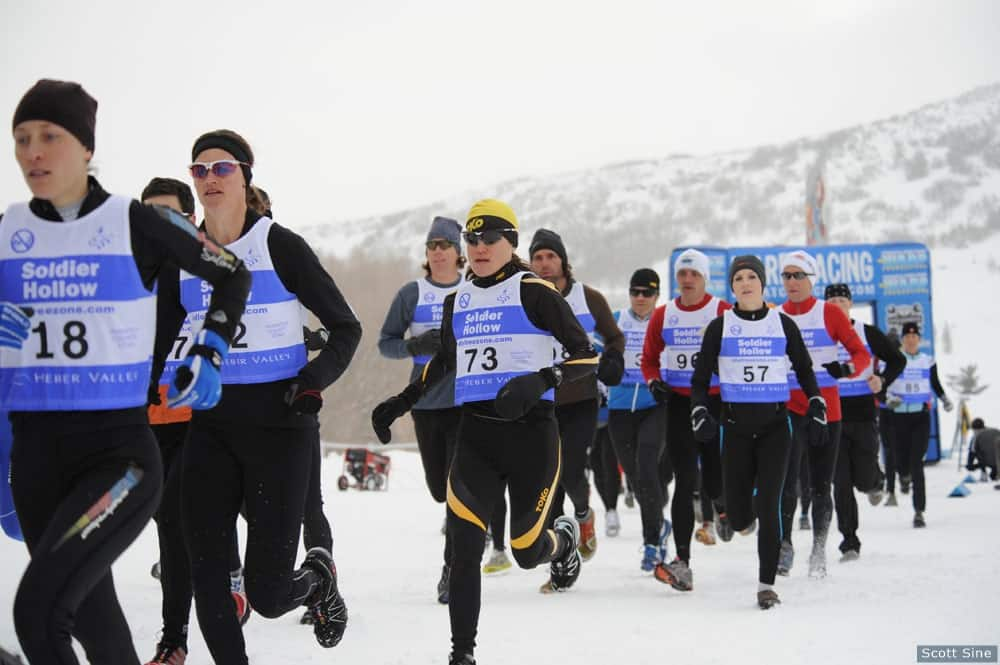Winter Triathlon #

Winter triathlon is not necessarily any triathlon occurring between November and March in the Northern Hemisphere. As its own sport, winter triathlon involves running, mountain biking, and cross-country skiing — all performed on snow. It is a perfect way to learn new sports, improve your base fitness, and expand your skills as a multisport athlete. The International Triathlon Union has been holding winter triathlon world championship races since 1997.
In winter triathlon, the running is contested on hard-packed snow courses (usually packed ski trails) with distances ranging from 5-9k. Racers typically wear normal running shoes or cross country spikes.
The mountain bike leg is held on packed ski trails for a distance of 10-15k. Competitors ride standard racing mountain bikes, often equipped with relatively wide tires run at low (about 15-20 psi) pressure. Tires with spikes are legal, though most competitors shun their use because of the additional weight.
The final event of winter triathlon is cross-country skiing. Courses are usually 8-12k in length and are contested on groomed Nordic ski trails. Classic or freestyle (skating) techniques are allowed, though most serious competitors use the freestyle technique as it is faster.
Most race courses involve multiple laps of each leg to add to the spectator friendliness of the races. There is also a team relay race at the world championship. The team relay involves three athletes per nation, where each athlete completes a short distance of each of the three disciplines (i.e. 2k run, 5k bike, 3k ski) before tagging the next athlete for their turn.
Getting Started
Below are helpful hints to get you started with winter triathlon training. It is a great way to break up the monotony of indoor workouts for those who live in climates with a real winter season.
Running
Equipment – Trail shoes, cross country spikes or racing flats equipped with sheet metal screws (1/8 inch) are the best choices for winter triathlon. As the footing on snow is somewhat challenging, racers will want a relatively supportive shoe.
Technique – Running on snow is not significantly different than running on hard ground. Keeping a relatively high turnover and using a midfoot to forefoot strike is optimal. Over-striding can cause you to punch into the snow each step. When possible, follow the footsteps of a runner ahead of you.
Cycling
Equipment – Any mountain bike with large width tires (at least 2.0 inches, 2.2 to 2.4 inches recommended) and aggressive tread will work well. Run relatively low tire pressure, down to 10-20 psi. Helmets are mandatory.
Technique – Mountain biking is a balance sport, and in the snow it requires even more balance than ever. Occasionally, to avoid spinning your rear tire, you may need to push a slightly larger gear than normal. Staying relaxed and not over-steering will go a long way toward keeping you upright.
Skiing
Equipment – Both skating or classic style skiing are legal in winter triathlon. In general, skating is a faster technique, so most racers will use the skating technique. A supportive boot, poles and skis that are the appropriate length and stiffness, and proper preparation of your skis (i.e. waxing) are the key elements and equipment required to ski. Most Nordic ski areas offer rental skis.
Technique – Your finesse, and not your fitness, will be the key to skiing fast. In winter triathlon, the most technically and aerobically taxing event is placed at the end; making for a challenging situation. Practicing your balance and specific ski techniques are paramount to becoming an efficient skier. Skiing without poles is an excellent drill to improve your ski technique.
Common Race Distances
|
|
RUN |
BIKE |
Cross Country Ski |
|
Short |
|
|
|
|
Kilometer |
1.6-6.3 |
8 - 30 |
3k - 5k (5K) |
|
Mile |
1-3.9 |
5-18.6 |
1.9m - 3.1m (3.1) |
|
Intermediate |
|
|
|
|
Kilometer |
6.4-12.8 |
30.1 - 50 |
7.5k - 12.5k (10K) |
|
Mile |
4.0-8 |
18.7-31 |
4.6m - 7.8m (6.2) |
|
Long |
|
|
|
|
Kilometer |
12.9-29.9 |
50.1-99.9 |
20k - 30k |
|
Mile |
8.1-18.5 |
31.1-62 |
12.5m - 18.5m |
|
Ultra |
|
|
|
|
Kilometer |
30+ |
100+ |
50k + |
|
Mile |
18.6+ |
62+ |
31m |
Winter Triathlon: Distances are categorized by using the category in which two of the distances fall. If all three are in separate categories the distance is categorized by the bike.
Youth
|
Race Age |
RUN |
BIKE |
Cross Country Ski |
Best Practices |
|
Youth 7-8 |
1 K |
2 K |
.1 - .5 K |
Short loop with flat terrain for the ski portion. |
|
Youth 9-10 |
1 K |
3 K |
.1 - .5 K |
Short loop with flat terrain for the ski portion. |
|
Youth 11-12 |
2 K |
5 - 7 K |
1 K |
Short loops with minor variation in terrain but no steep hills for the ski portion. |
|
Youth 13 - 15 |
2 - 3 K |
8 - 10 K |
2 - 3 K |
Short loops with minor variation in terrain but no steep hills for the ski portion. |
Transitions
Run to Bike – Be sure that your bike equipment is easy to use with gloves on. Putting on a heavier glove and/or jacket for the bike section is often necessary to stay warm.
Bike to Ski – You are allowed to ski with your bike helmet on, but it's not cool. Ski boots are not the fastest or easiest shoes to take on and off, and you must carry your skis and poles out to the mount line. Practice makes perfect!
Future
Winter triathlon is a growing sport. The ITU hopes winter triathlon will be an Olympic sport in the future.